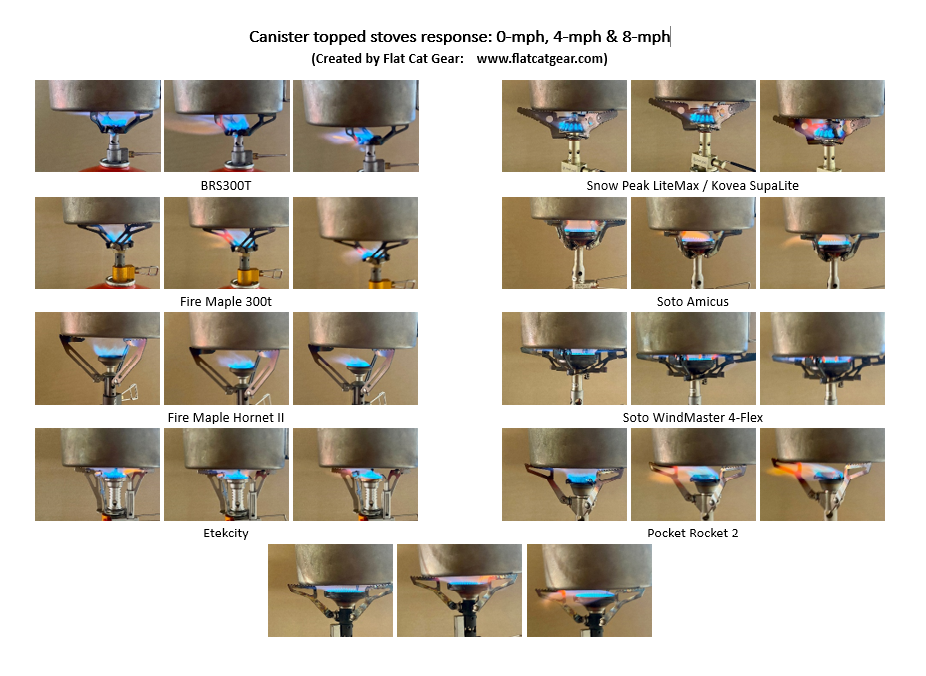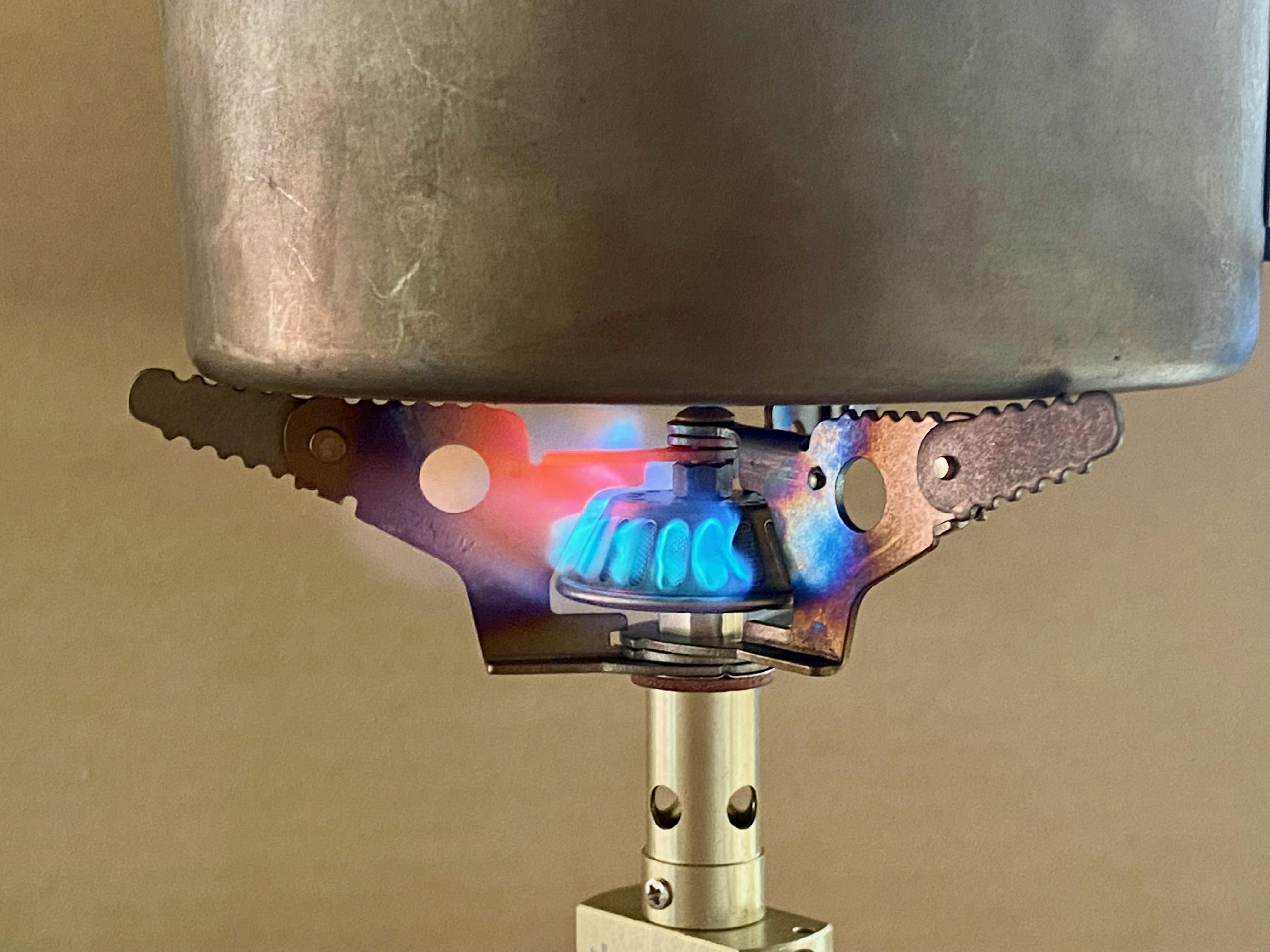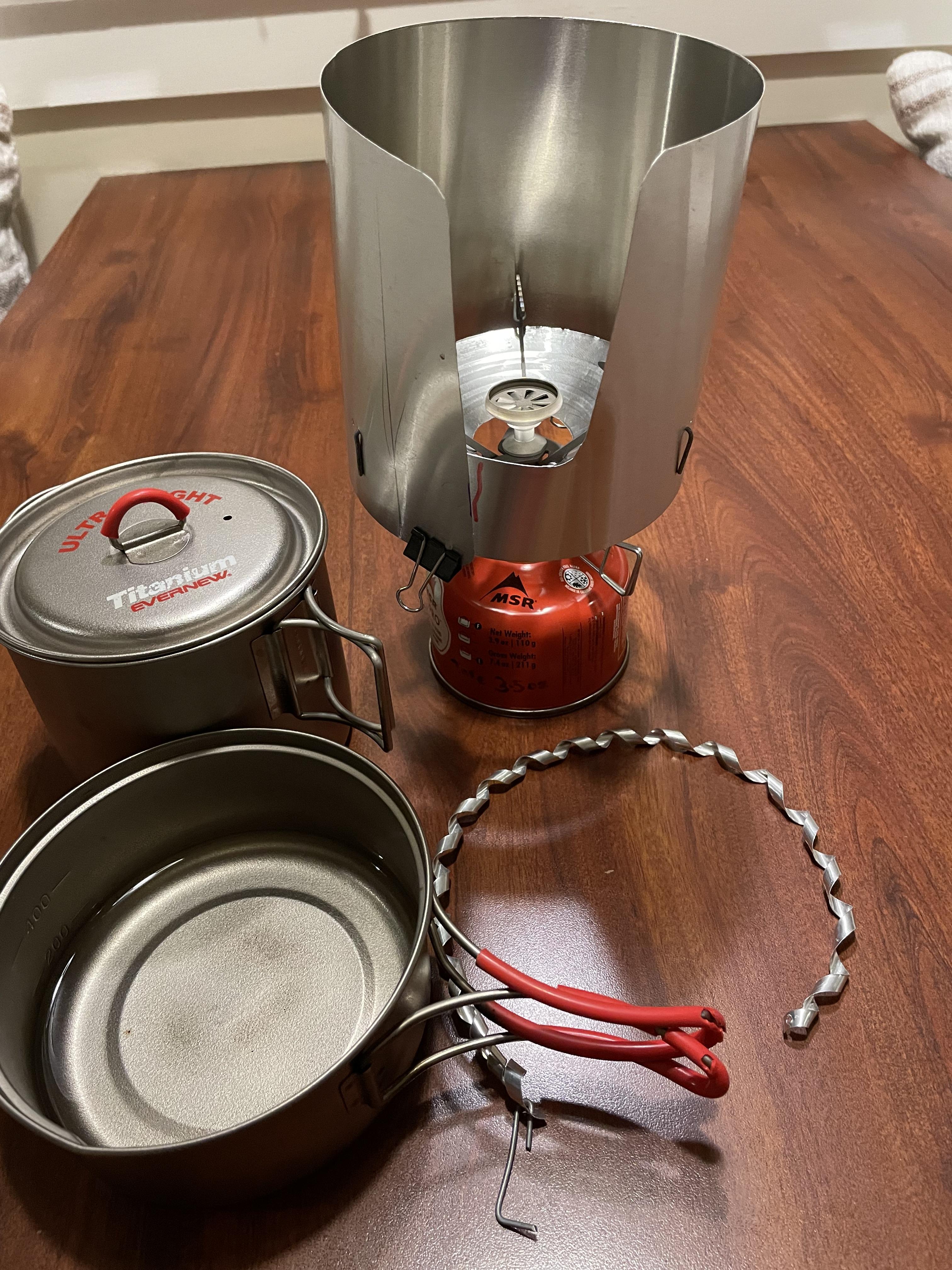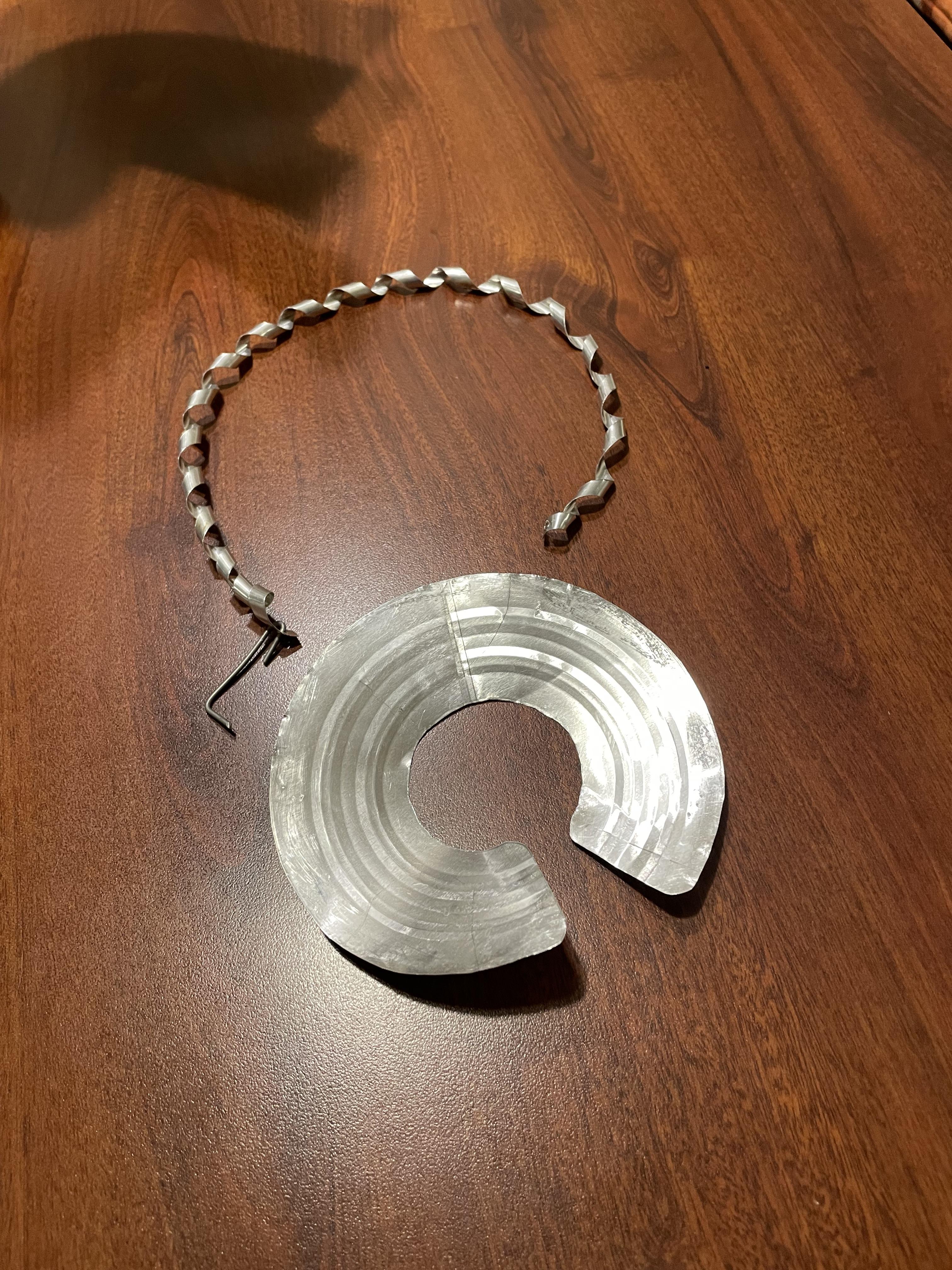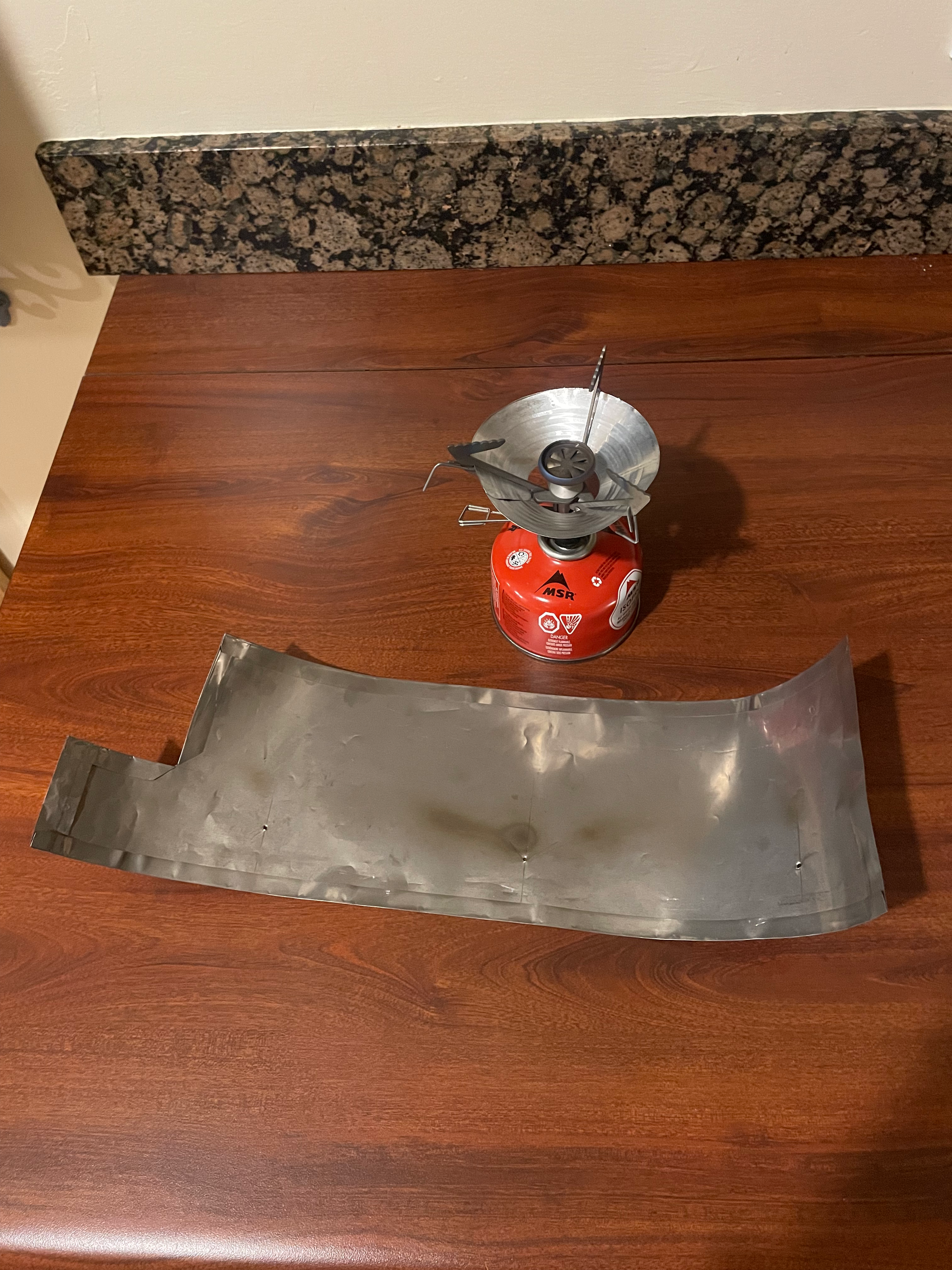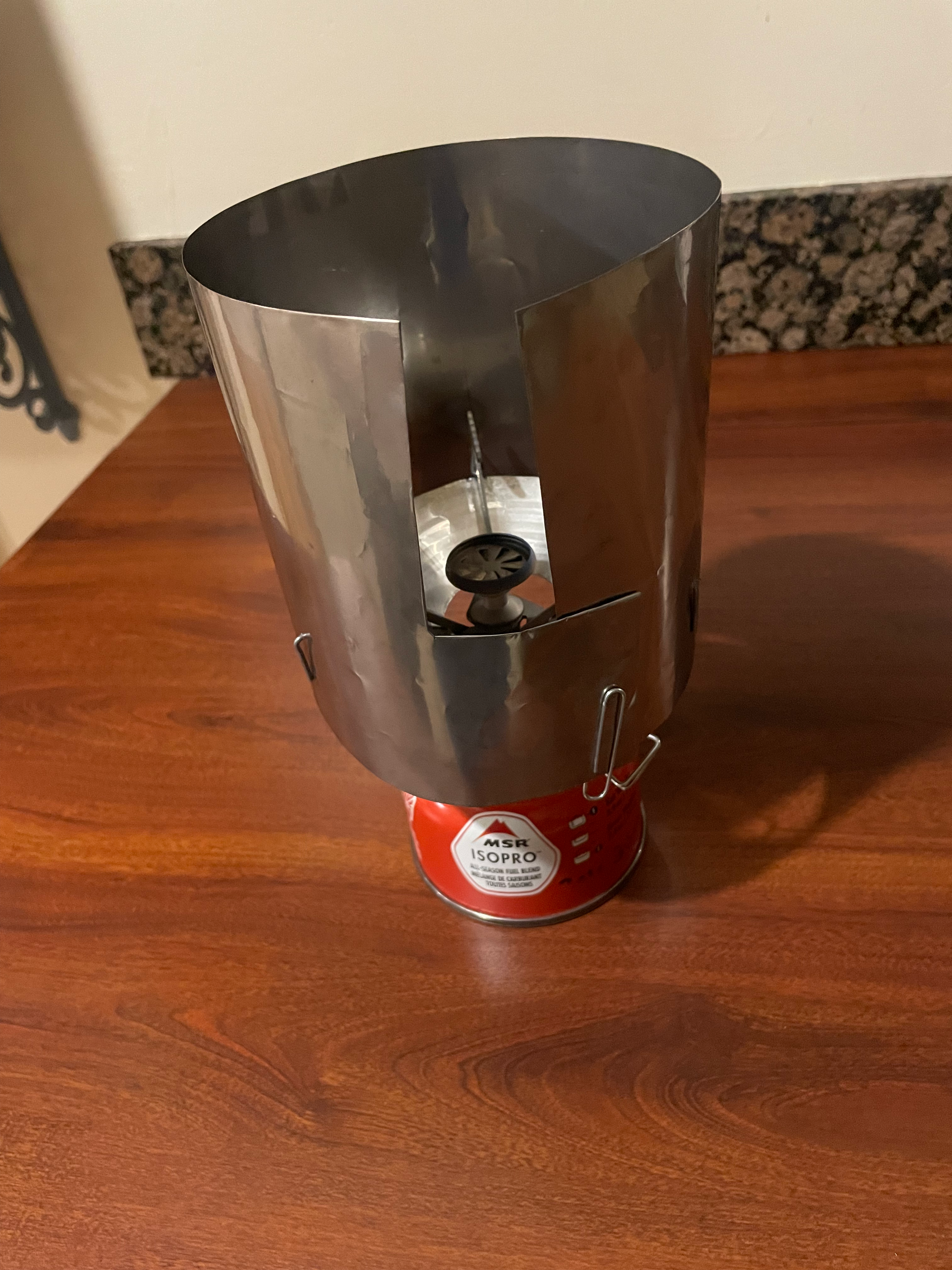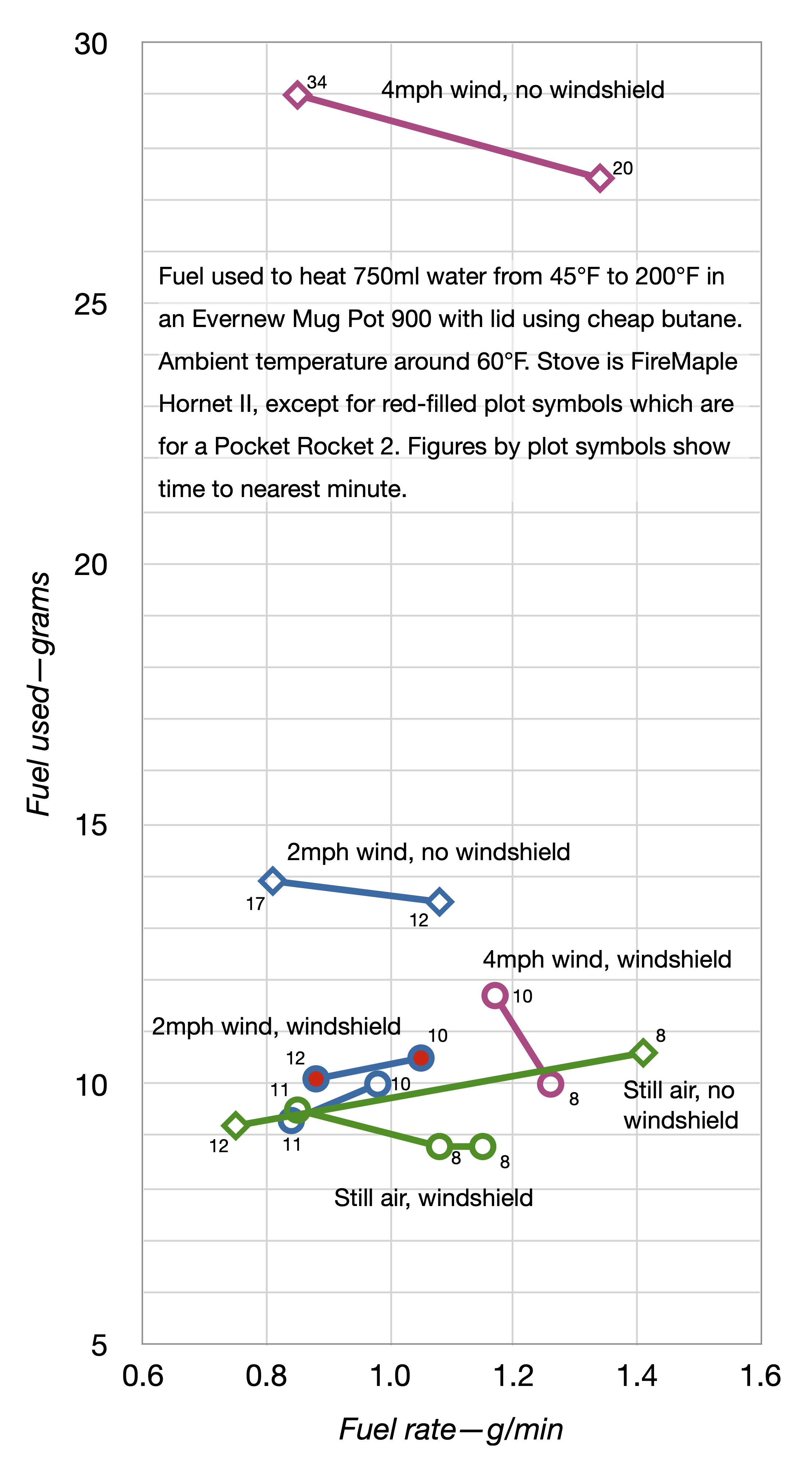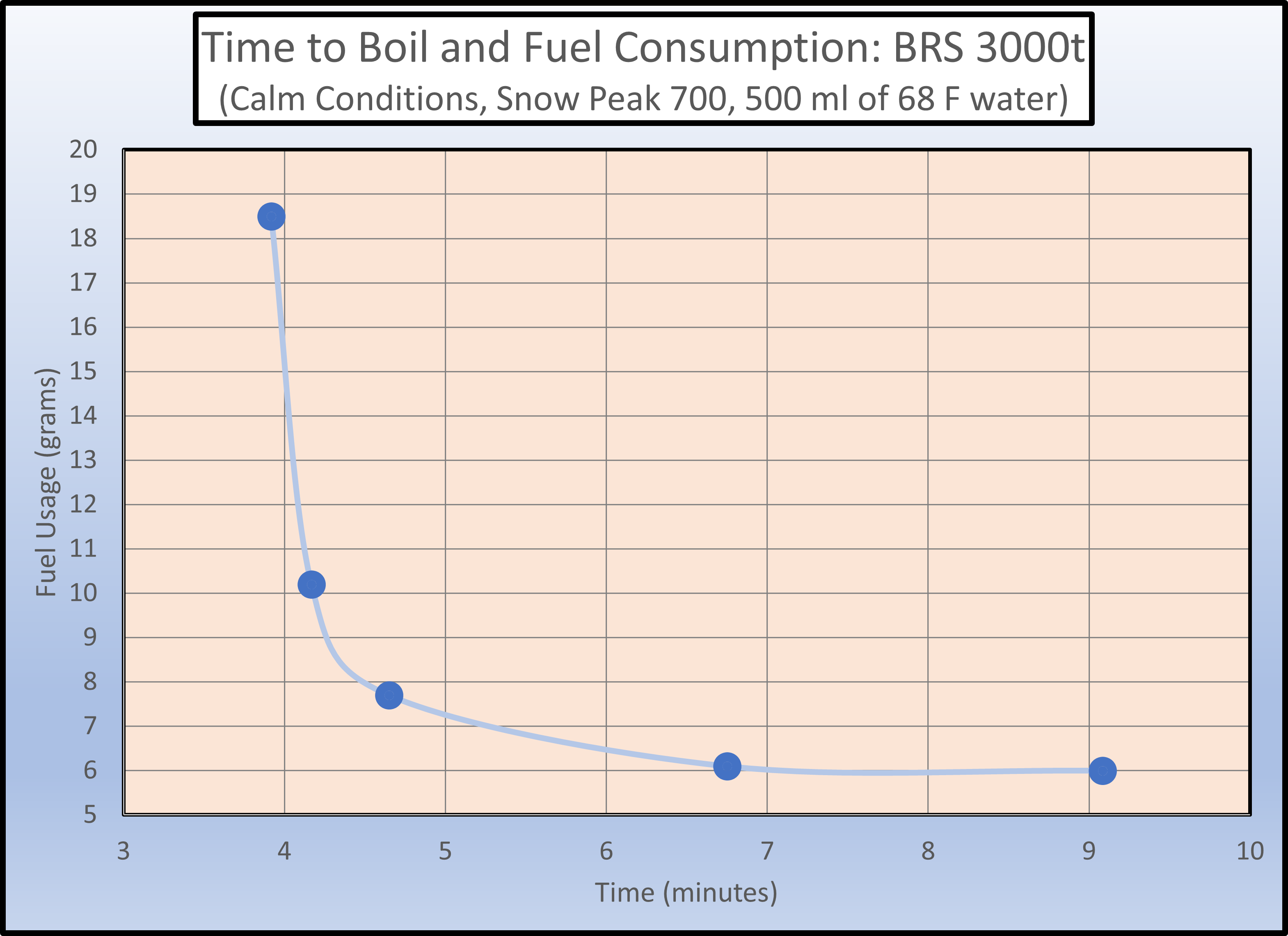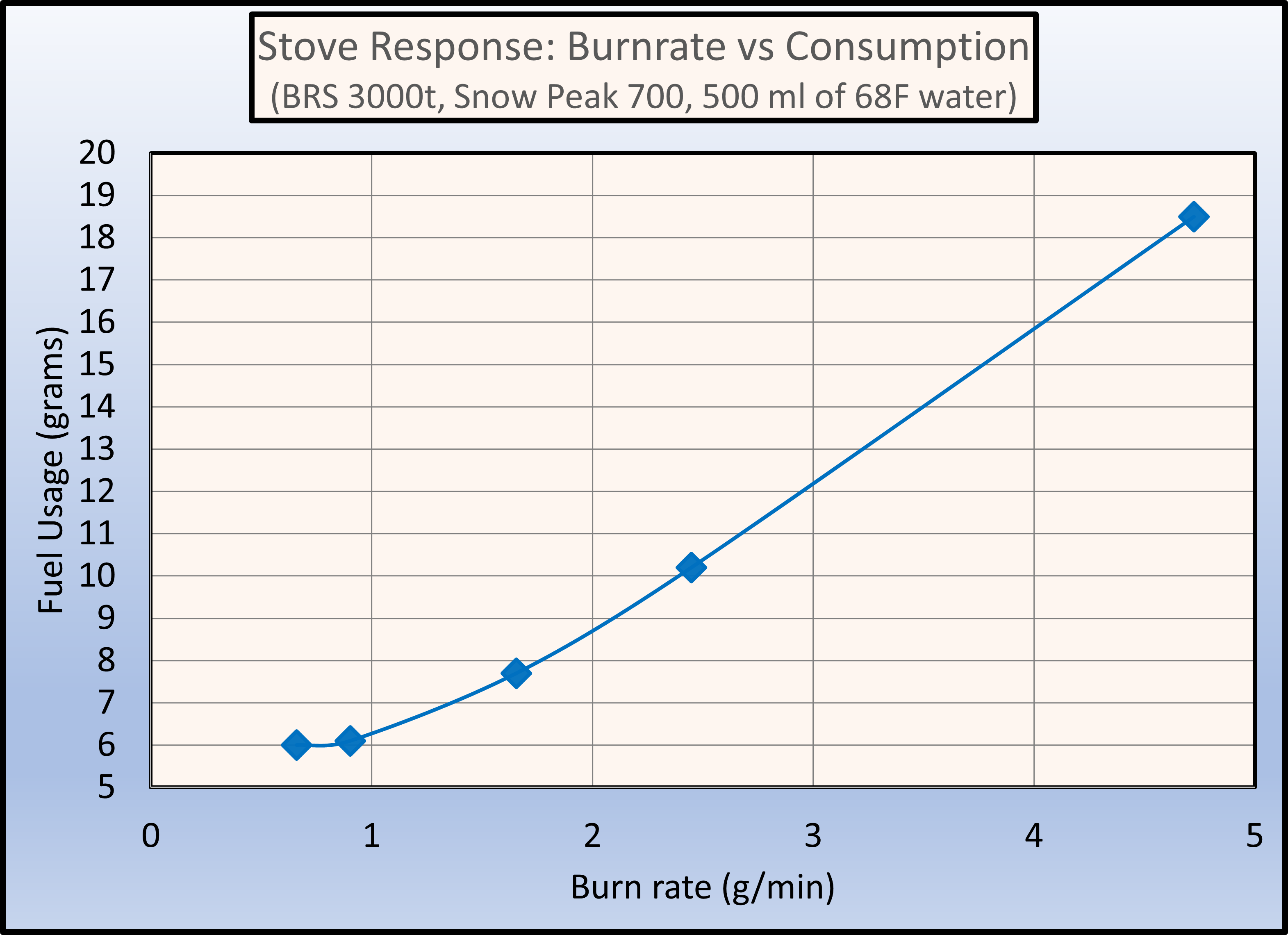Topic
Canister Topped Stove Performance in the Wind
Forum Posting
A Membership is required to post in the forums. Login or become a member to post in the member forums!
Home › Forums › Gear Forums › Gear (General) › Canister Topped Stove Performance in the Wind
- This topic has 45 replies, 9 voices, and was last updated 10 months, 3 weeks ago by
 Adrian Griffin.
Adrian Griffin.
-
AuthorPosts
-
Aug 10, 2023 at 3:50 pm #3786434
I just compiled a bunch of photos and videos of various canister topped stoves operating in my wind tunnel. The visuals provide a bit of insight with respect to fuel efficiencies and sensitivities to the wind.

Photo Overview
 Aug 10, 2023 at 4:23 pm #3786437
Aug 10, 2023 at 4:23 pm #37864372 things really stand out to me in those photos…
- The Windmaster is in a class of it’s own.
- The BRS and Fire Maple stoves are as well…bottom of the class.
The PR2 shares a similar head design to the Windmaster, but seems to demonstrate the importance of getting the burner to pot bottom distance correct.
Question: do you think the off center pot positions on some of the stoves affects the flame shape? Pots that are not centered appear to be offset to windward.
Aug 10, 2023 at 4:38 pm #3786438The short answer is that I don’t believe being off-centered contributes that much because the pot to burner distance is so large. The gap of the Pocket Rocket Deluxe is significantly larger than the Soto WindMaster. I would have to double check, but I think that the gap was 0.15” larger. The mug was more centered than it looks, the most it would have been off was about 1/2”. My 2 cents.
Aug 11, 2023 at 12:02 pm #3786451Is it my imagination, or is the Snow Peak not effected that much, maybe due to burner design?
Aug 11, 2023 at 12:25 pm #3786452Bill,
The Snow peak LiteMax / Kovea SupsLite stove is not known for being robust in the wind. The pot support arms divide the burner head up into 3 sections. If you look at teh furtherest jet to the right, you can see that it is not lit. You can’t see it but 1/3 of the jets that are facing teh wind are also not lit. This shot is when the wind is blowing at 8-mph.
 Aug 11, 2023 at 5:56 pm #3786466
Aug 11, 2023 at 5:56 pm #3786466I am not sure I agree with Jon about some of the details in the last photo.
Looking at the second slot from the right, I can see that the flame is being blown to the left a lot. The flames from the other slots are mostly short, but longer to the left. I would interpret the pic overall as saying that the wind was pushing the gas at the last slot to the right back into the burner head, and maybe out the slots to the left.
All of which reinforces my conviction that all stoves need to be sheltered from the wind with a windshield (unless you are indoors maybe). After a few days of excess fuel usage with an unshielded burner, I reckon a windshield would end up lighter. A tailored Ti foil windshield is very light you know.
My 2c. HTH.
CheersJan 30, 2024 at 10:21 am #3802674GearSkeptic just released this video about canister topped stoves and windscreen performance in the wind. Long but valuable. My 2 cents.
 Jan 30, 2024 at 4:04 pm #3802699
Jan 30, 2024 at 4:04 pm #3802699All very interesting, but (of course) there are some parts I disagree with.
First of all, many of the burns show the flames coming up the sides of the pot. That is, very bluntly, wasteful of fuel. The heat in the flames going up the sides is lost.
The ‘floor’ thing is, in some cases, really screwing up the design and operation of the BRS-3000T stove. Without that floor the flame is as it should be: strong, well stratified and going upwards. ‘Stratified’ in this case means the flames have the right colour profile matching the various stages of combustion: first the hydrogen burns, then the carbon -> carbon monoxide, and then CO -> CO2.
With the floor in place the flames go everywhere, and they are probably leaving a lot of unburnt carbon monoxide. To understand why this is so requires that we look at where the oxygen comes from. The secondary oxygen (which is essential) comes from outside the flame and diffuses into the flame. For that to work properly you need the primary oxygen flow, and with the floor in place that is almost completely missing. Why? Well, the primary oxygen supply is dragged in through the air holes by the strong jet of vapour coming through the jet. The floor is fouling that flow so badly that little air is being sucked in. The aerodynamics around the jet are really fouled up.
Bottom line: with the ‘floor’ in that position right next to the air inlets, you not only get poor fuel efficiency, but you probably also get a lot of carbon monoxide being emitted. This is a bad thing – dangerous for your health.
Cheers
Feb 2, 2024 at 5:37 pm #3802977I’m making a windshield for a newly-acquired FireMaple Hornet II. After watching the Gear Skeptic’s latest video, reading this thread, and looking at zenstoves.net, I want to make sure my windshield isn’t reducing efficiency by blocking secondary air, making the mixture too rich.
Using my prototype with the pot and windshield in place, the flame is all blue and violet. Does this mean that all or most of the CO is getting oxidized and I’m not losing efficiency? Or is there anything else I can do to check that the windshield isn’t interfering with combustion?
Feb 2, 2024 at 7:37 pm #3802978A key objective to a windscreen is to keep the flame front stable and in contact with the pot/mug bottom. Shielding below the burner head is good but not nearly as critical. For grins. You could make your windscreen and then trim the bottom just to see the “cause and effect” on the flame profile. My 2 cents.
Feb 2, 2024 at 8:14 pm #3802985the flame is all blue and violet. Does this mean that all or most of the CO is getting oxidized and I’m not losing efficiency?
Most likely.
If removing the windshield does not make for any significant (noticeable) change to the appearance of the flame, then you are fine.Cheers
Feb 2, 2024 at 9:42 pm #3803005Thanks, Jon. Just for grins, this is where I am now. I’m prototyping with flashing stock from Home Depot, but the final will be 0.1 or 0.05mm titanium from Ali Express. I plan to hold the shield shut with hammer-in snaps, where you see the office clip.
The diameter of the main shield is set to fit snugly around my smaller pot that does a 300 ml boil for dinner and breakfast oatmeal. Over a trip, most of my fuel goes to the 740ml boils for tea in in the narrower, taller kettle. The curly thing is a heat exchanger that wraps around the kettle, filling the gap between the kettle and the shield. Maybe it traps some heat, but anyway it makes the shield more stable.
The reflector, made from a foil pie dish, fits nicely in the slots in the Hornet II pot arms.
So far, blue flames. Haven’t tested it with a fan yet.

 Feb 2, 2024 at 10:05 pm #3803010
Feb 2, 2024 at 10:05 pm #3803010The curly thing is a heat exchanger that wraps around the kettle
Cool: At one time, I was looking into a garter spring to help slow down the vertical airflow. Never pulled the trigger on buying one though. FYI – I have experimented with tall section above the burbner as shown. My concern is that the metal could easily get red hot. Keep up the great work!
Mar 10, 2024 at 9:09 pm #3805531Hey Jon. This is the beta titanium version of my tall windshield. It’s made from 0.05mm foil that’s plenty stiff enough with a 10mm fold along the edges. So a 150mm piece, available from AliExpress, gives me a 130mm tall windshield. Currently, it’s held closed with a paperclip, but I plan to try making a toggle from 1mmx8mm magnets. Weight is 13g.
The windshield doesn’t get at all hot, at least with a medium or low flame. For my tests, I’m fueling with cheap butane, which gives much less vigorous flame than isobutane-propane mix. The temperature of the lower end of the shield never got above about 120°F. The canister chills to 50–60°F under all conditions. No danger of overheating.
The effect of wind on an unshielded Hornet II is dramatic. With a 4mph breeze, it took 28g of fuel to do my standard boil. A windshield cuts fuel use significantly. Full details are in the graph.
I used the same delta-T (45–200°F) as the Gear Skeptic. But I did a larger 750ml “boil” to reduce the effect of timing and measurement errors. Also, that’s what I use for my tea boils on the trail which is where most of the fuel goes. Breakfast oatmeal and freeze-dried dinners are only 150–300 ml boils.
I used cheap spray-can butane, but I think the results are valid for isobutane-propane mix. The calorific value and latent heat of n-butane is about the same as for isobutane. The only difference is the lower vapor pressure. This limits the fuel rate at wide valve openings, so at 60°F I couldn’t do a full-power fast boil. But that would probably be past the point where efficiency is dropping due to flame spillage.
So the takeaways are …
In perfectly still air, the windshield only saves a gram or so per boil. At 2mph—slight air movement, not even a breeze—the windshield saves 3g per boil. At 4mph, a light breeze on the Beaufort scale, the windshield saves 15 or more grams per boil.
In most cases, a 13g windshield will pay for itself in fuel weight savings. The only exception might be a 2–3 day trip, cooking in shelters or places where still air is guaranteed.
Low fuel rates make for more efficient use of fuel, particularly when the air is calm and the pot is well shielded.
For comparing stoves under real-world outdoor conditions, a realistic baseline seems to be 2mph wind with a windshield. Under these conditions, the Hornet II did slightly better than a Pocket Rocket 2. Other testers have reported the Hornet II to be less efficient than the PR2, likely because the flame and heat blow away in the 28mm gap between the burner and the pot bottom. But the windshield traps this heat. Maybe there’s more secondary combustion of CO under the pot. So a windshield and an enclosed flame area are the keys to efficiency.
It might turn out that there’s not much difference between any stoves if the flame area is enclosed. Anyway, the Hornet II looks good. Cheaper and 24g lighter than the PR2.
Windshields rule!


 Mar 10, 2024 at 9:24 pm #3805534
Mar 10, 2024 at 9:24 pm #3805534It might turn out that there’s not much difference between any stoves if the flame area is enclosed.
That is my opinion too. I would say that stove power is mainly set by the size of the jet, which of course controls the amount of fuel burning.Cheers
Mar 11, 2024 at 9:17 am #3805543Of course, I love looking a data, great charts. Keep up the great work!
The Fire Maple Hornet II and the BRS 3000t suffer from the same sensitivity to the wind: too large of a burner to pot distance.
Agreed, at 4 mph and above tends to really separate stove performance. Maybe Ryan could include it in his Stovebench test. It would be nice to see the addition of the PRD at 4 mph.
There are some oddities like “why are some of the slopes positive? Negative slopes make sense to me”. I wonder if a third data point would help (to the right maybe?)
What are the advantages of plotting the X-Axis as g/min rather than minutes? Curious.
BTW, below are the results of running the BRS 3000t at varies speeds in calm conditions (minutes for me not g/min). It shows the nonlinearity of stove outputs in order to optimize fuel efficiency.
 Mar 11, 2024 at 10:55 am #3805547
Mar 11, 2024 at 10:55 am #3805547For grins, I replotted the datat using your format g/min. One of the differences is that I go to much higher burn rates (g/min).
 Mar 11, 2024 at 10:55 am #3805548
Mar 11, 2024 at 10:55 am #3805548deleted double post
 Mar 12, 2024 at 12:32 pm #3805602
Mar 12, 2024 at 12:32 pm #3805602Thanks for posting the graph of fuel use vs. fuel rate. I was about to ask you to send me the data so I could plot it.
I used fuel rate as my x-axis because it’s the the variable I control. Or at least, I control it implicitly by valve position and burner sound and then calculate the actual value from before-and-after fuel weights and elapsed time. The data could be plotted any way.
I think fuel rate on the x-axis makes it easier to compare conditions—that’s a combination of windspeed, stove type and windshield on or off. I’m only doing two or three fuel rates for each condition. I can’t assess the full trajectory of fuel use vs time or fuel rate as you did in your five-point graph for the BRS 3000t in still air. But I can assess how wind speed and use of a windshield affect overall fuel use. Time to boil is of less importance to me, provided it’s not unduly long.
The variation in the slopes of the lines for each condition generally make sense. Looking at the green (still air) lines you can see that at a fuel rate of about 0.85 g/min there’s very little difference in fuel use between windshield and no windshield. At higher fuel rates with no windshield, overall fuel use goes up slightly. Time is shorter with less heat lost from the pot to the air, but this is outweighed by increased flame splashout. With a windshield, fuel use goes down with a higher fuel rate. There’s less time for heat loss, and the windshield cuts the rate of heat loss and waste from flame splashout.
The 2 and 4 mph no-windshield lines both slope down with increasing fuel rate. That’s the reverse of the behavior for still air, no windshield. Here, removal of heat by air movement is taking over. Low fuel rates with their long boil times end up using more fuel.
The blue 2 mph with-windshield line slopes up. At 0.85 g/min, fuel use is about the same as both of the still-air conditions. At 0.98 g/min, overall fuel use is higher. Here, the additional flame splashout outweighs savings savings in heat loss from the one-minute shorter boil time. Speculation, but it’s consistent with the results for the PR2.
The purple 4mph with-windshield line is puzzling. Fuel use at 1.17 g/min doesn’t seem out of line, but the sharp drop at a slightly higher fuel rate is suspect. But the boil time dropped from 10 minutes to 8 minutes, so there was 20% less time for the 4mph breeze to blow away the heat. This test is a candidate for repeating.
The 2mph windshield test for the PR2 is similar to the test for the Hornet II, but fuel use is slightly higher. Seems that even under slight air movement, windshield design is more important than stove design.
The upshot of all this is to use the lightest stove that has adequate pot supports, devise a windshield that encloses the flame area and at least part of the pot, and keep the fuel rate low.
BTW, back to your five-point graph. It’d be interesting to see where the curve turns up as you reduce to very low fuel rates. Maybe around 0.4g/minute? Also, what’s the boiling point of water at your place?
Mar 12, 2024 at 2:14 pm #3805606The 2mph windshield test for the PR2 is similar to the test for the Hornet II, but fuel use is slightly higher. Seems that even under slight air movement, windshield design is more important than stove design.
In windy conditions with a Canister Topped stove, I agree with you 100%.
The upshot of all this is to use the lightest stove that has adequate pot supports, devise a windshield that encloses the flame area and at least part of the pot, and keep the fuel rate low.
I am not fully behind this one. The best option is the one that you are will to use. I myself would pick the Soto WindMaster stove as it is extremly robust in the wind. Up to say 5 mph, I wouldn’t bother with a windscreen. Windscreens are great but do come with a fiddle factor and are probably the weakest link in a stove cooking system (as in easy to damage).
BTW, back to your five-point graph. It’d be interesting to see where the curve turns up as you reduce to very low fuel rates. Maybe around 0.4g/minute? Also, what’s the boiling point of water at your place?
The fuel rate tends to creep up with long boil times (or low g/min values) but not appreciatively. Efficiency degrades a lot quicker with high burn rates. BP at my elevation is about 210-211 F. Best regards.
Mar 12, 2024 at 2:17 pm #3805607It shows the nonlinearity of stove outputs in order to optimize fuel efficiency.
May I just slightly rephrase that?
I think it shows the way heat is lost up the sides of the pot when the flames are too big for the size of the pot. After all, we do know that wide pots are more efficient than narrow pots.
This gets some mention in
https://backpackinglight.com/heat-exchanger-pot-test-hx-haa-caffin/What that article also shows is that having a windshield around the pot has a large effect on the efficiency. It traps the hot air close to the sides of the pot, and that works.
A deficiency in that article is that I did not test really high powers. I limited the burn rate to under 3 g/min, and often ran lower than that. I did not have flames going beyond the edge of the pot as I never do that in the field.
Cheers
Mar 12, 2024 at 2:34 pm #3805610“The upshot of all this is to use the lightest stove that has adequate pot supports, devise a windshield that encloses the flame area and at least part of the pot, and keep the fuel rate low”
GearSkeptic tests were illuminating and support the first part (BRS+eg Ocelot mini).
He found the highest efficiency is by using the minimum fuel rate that still gives adequate flame contact with the pot. His video provides a nice visual example.
I like his visual examples because they’re easy to apply in the field, just like his video showing the boil bubble size equating to 190F so to not need to boil too long.
Mar 13, 2024 at 2:37 pm #3805647My canister -top stove is a BRUNTON CRUX that folds for storage. Heavier than some but it has the larger diameter burner I like. (No hot spots on my pot.)
MY WIND SCREEN(S): Circular bottom screen W/ center hole for stove canister screw. It is held in place by being “clamped” between the stove and canister. This lower screen is the base for a shortened MSR wind screen that sits on top. The base screen is cut in half through the center hole and held together with duct tape so I can fold it for storage. Works for me.
Mar 13, 2024 at 2:43 pm #3805649My canister -top stove is a BRUNTON CRUX that folds for storage. Heavier than some but it has the larger diameter burner I like. (No hot spots on my pot.)
MY WIND SCREEN(S): Circular bottom screen W/ center hole for stove canister screw. It is held in place by being “clamped” between the stove and canister. This lower screen is the base for a shortened MSR wind screen that sits on top. The base screen is cut in half through the center hole and held together with duct tape so I can fold it for storage. Works for me.
BTW, Roger Caffin restates the truth that pots “wider than tall” are most efficient. (Do you hear that “mug cookers”?) That’s why I always use my Open Country anodized aluminum 3 cup pot. I actually do cook some meals like re-hydrating spaghetti sauce and cooking spaghetti. I need a pot, a plastic cup and a small plastic bowl for this kind of cooking. OK, so I add maybe 2 or 3 oz. but the convenance is worth it.
Mar 13, 2024 at 3:08 pm #3805653From our friend the “Amazing Randy of Backpacking”, GearSkeptic
No wind, the minimum weight (including fuel) is often small diameter bowl: https://youtu.be/J9Sz3IQ_DW4?t=2584
Counterintuitively, at high wind with no screen, the small diameter bowl is more fuel efficient: https://youtu.be/6r-2hZ8UCeA?t=1378
Confused yet?
-
AuthorPosts
- You must be logged in to reply to this topic.
Forum Posting
A Membership is required to post in the forums. Login or become a member to post in the member forums!
Our Community Posts are Moderated
Backpacking Light community posts are moderated and here to foster helpful and positive discussions about lightweight backpacking. Please be mindful of our values and boundaries and review our Community Guidelines prior to posting.
Get the Newsletter
Gear Research & Discovery Tools
- Browse our curated Gear Shop
- See the latest Gear Deals and Sales
- Our Recommendations
- Search for Gear on Sale with the Gear Finder
- Used Gear Swap
- Member Gear Reviews and BPL Gear Review Articles
- Browse by Gear Type or Brand.


